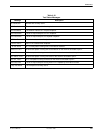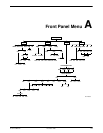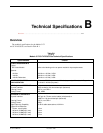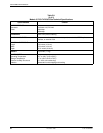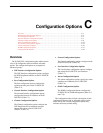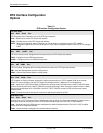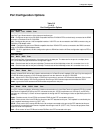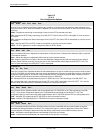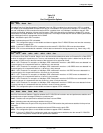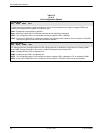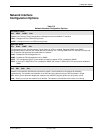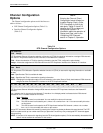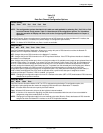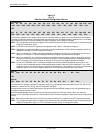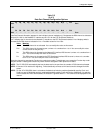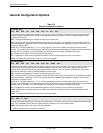
Configuration Options
C-53170-A2-GB20-20 December 1996
Table C-2
(3 of 4)
Port Configuration Options
EDL: Disab
Next Enab Disab Prev
Embedded Data Link. Specifies whether Embedded Data Link (EDL) is enabled for a particular port. If EDL is enabled,
then 8 kbps of the total bandwidth allocated for this port is not available to the synchronous data port. For example, if the
port rate is 256 kbps (4 DS0 channels allocated) and EDL is enabled, then only 248 kbps is available to the port. EDL
provides the following: detection of frame synchronization, CRC of the data stream (excluding the 8 kbps EDL), and an
in-band data link (4 kbps) between the local and remote units. The 4 kbps in-band data link can be used for performance
report messages and as a management link for SNMP.
Enab – Indicates the port’s EDL is enabled.
Disab – Indicates the port’s EDL is disabled.
NOTE: This configuration option is not available and does not appear if the E1 DSU/CSU does not have the necessary
hardware to support EDL.
NOTE: If the local E1 DSU/CSU’s EDL is enabled, then the remote E1 DSU/CSU’s EDL must also be enabled.
NOTE: EDL is not recommended for networks in which data is examined for routing purposes (e.g., frame relay, x.25).
Err Rate: 10E-4
Next 10E-4 10E-5 10E-6 10E-7 10E-8 10E-9 Prev
Port Excessive Error Rate Threshold. Sets the error rate threshold that determines when an Excessive Error Rate (EER)
condition is declared for a particular port. The error rate selected by this configuration option is determined by the ratio of
the number of CRC5 errors to the total number of bits received over a set period of time.
10E-4 – 10E-4 Threshold. For example, at 1984 kbps, EER is declared if more than 1,983 CRC5 errors are detected in a
10-second period. It is cleared with less than 1,984 errors in ten seconds.
10E-5 – 10E-5 Threshold. For example, at 1984 kbps, EER is declared if more than 1,189 CRC5 errors are detected in a
60-second period. It is cleared with less than 1,190 errors in sixty seconds.
10E-6 – 10E-6 Threshold. For example, at 1984 kbps, EER is declared if more than 119 CRC5 errors are detected in a
60-second period.
It is cleared with less than 120 errors in sixty seconds.
10E-7 – 10E-7 Threshold. For example, at 1984 kbps, EER is declared if more than 11 CRC5 errors are detected in a
60-second period. It is cleared with less than 12 errors in sixty seconds.
10E-8 – 10E-8 Threshold. For example, at 1984 kbps, EER is declared if more than 53 CRC5 errors are detected in three
15-minute intervals. It is cleared with less than 54 errors in three 15-minute intervals.
10E-9 – 10E-9 Threshold. For example, at 1984 kbps, EER is declared if more than 5 CRC5 errors are detected in three
15-minute intervals. It is cleared with less than 6 errors in three 15-minute intervals.
NOTE: This configuration option is not available and does not appear if EDL is disabled.
Near-end: Disab
Next Disab Maint Send Both Prev
Near-End Performance Statistics. Specifies whether the E1 DSU/CSU will maintain near-end performance statistics and
send performance report messages (PRMs) for a particular port.
Disab – Disables near-end performance statistics and does not send PRMs.
Maint – Maintains near-end performance statistics for this port.
Send – Sends PRMs over the port’s EDL every second. Each PRM contains the performance statistics for the previous
4 seconds.
Both – Maintains near-end performance statistics and sends PRMs over the port’s EDL.
NOTE: This configuration option is not available and does not appear if EDL is disabled.
NOTE: If the local E1 DSU/CSU is configured to send near-end performance statistics, then the remote E1 DSU/CSU
must be configured to maintain far-end performance statistics.



